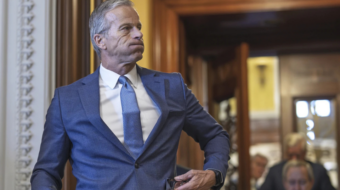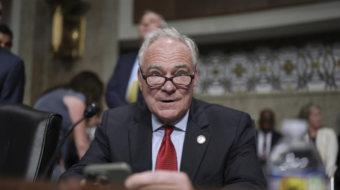
TAMPA, Fla.—With fewer than three months to go before the November general election, both candidates and activists are looking towards that contest rather than the August 23 primary.
The U.S. Senate race is set: Rep. Val Demings (D), a former Orlando police chief, will take on Sen. Marco Rubio (R). Depending on what polls you read, the race is either tied or Rubio leads, usually within the margin of error. She’s raised more money than he has.
But since Rubio has no primary foes, he’s got more money in the bank, while Demings had to spend all but $8.8 million of the $47.8 million she’s raised so far to fend off—or discourage—primary foes. Rubio has around $15 million in the bank, half of what he raised, but he will benefit from millions of dollars from the Republicans’ multitude of “dark money” campaign finance committees.
One positive Demings has going for her is her up-through-the-ranks ascension to become Orlando’s police chief before entering Congress. Republicans nationwide are running on hard-on-crime campaigns full of racial dog whistles, but such attacks fall flat in Florida against Demings, who is both a former police officer and Black. As chief, she says violent crime in Orlando fell 40% on her watch.
And given Florida’s huge retiree population, Demings is focusing on other matters. She’ll “lower the cost of prescription drugs and stand up to the special interests who want to undermine protections for people with pre-existing conditions like diabetes or asthma,” her campaign website says.
“Demings says she’s a few points up in the polls” over Rubio “but I don’t know the reliability of that,” Tampa activist John Streater, a retiree rep to the area Central Labor Council, said in a telephone interview. “My gut feeling is she’s got a pretty even shot.”
The two latest polls split: The Susquehanna poll, from August 8-10, gives Rubio a 50%-39% lead, while the University of North Florida poll, over the same time, gives Demings a 48%-44% edge.
There’s mobilization in the Tampa-St. Pete area, Streater added, but “the real mobilization has been by the FEA” and in the governor’s race.
Targeting DeSantis, the Trump clone
In that contest, Democratic Rep. Charlie Crist will first have to overcome state Agriculture Commissioner Nikki Fried in the primary before he can turn full attention to incumbent Republican—and Donald Trump clone—Ron DeSantis. The governor has his eye on the party’s presidential nomination in 2024.
Demings and Crist have strong labor backing, said both Streater and Florida Education Association President Andrew Spar. Labor backs Demings because of her background and Rubio’s pro-Trump voting record. In the gubernatorial tilt, Spar said in a telephone interview, DeSantis is so extremely pro-Trump—and anti-teacher—that he’s antagonized the union and hundreds of thousands, if not millions, of voters.
Crist, a former Republican governor before switching parties, may have had little choice but to seek the top state job again. DeSantis redrew Crist’s 13th Congressional District into one where the average Republican margin is 12 percentage points.
Crist has campaigned on protecting the right to vote, including reversing limits on mail ballots, enacting automatic voter registration, moving the primary from August to the spring, and ensuring everyone in the state has clean water, Ballotpedia reports.
Florida’s politically active teachers come into play, as they’ve been a favorite piñata for DeSantis during his entire four-year term. His “Don’t Say Gay” law, virtually banning teaching about sexuality in schools, was only the latest outrage.
And Florida has a new voter repression law, targeting African-Americans, that rivals Georgia’s, says AFT Secretary-Treasurer Fedrick Ingram, the former FEA president, where he headed the state’s joint NEA-AFT affiliate and one of its largest unions.
DeSantis and the Republican legislature also tried to overturn a 2020 referendum restoring the right to vote to more than a million former prisoners who completed their sentences. Some 47% of current Florida inmates are Black, almost three times the Black share (17%) of its people.
Florida’s teachers “see this stuff very clearly,” said Spar, Ingram’s FEA successor. “One of my challenges is to tie the labor movement to the Black community’s struggle. We’re overlapping and should be working together.”
Congressional contests
The congressional delegation is so gerrymandered, by DeSantis, overriding the Republican-run legislature, that though Florida gained a seat after the 2020 census, it’ll lose at least one Black representative. The number of safe Republican or leaning Republican seats went from 14 out of 27 total in the current map to 18 out of 28 in the new one, Ballotpedia calculates.
Democratic Rep. Al Lawson’s Fifth District from Jacksonville to Tallahassee, the state capital, was 48% African-American. It was cut up and its residents distributed—swallowed would be a better term—into surrounding white-dominated districts. Lawson is running in the new 2nd District. Black state legislators conducted a sit-in to protest the dismemberment.
The sole Black Floridian whose district didn’t radically change is Frederica Wilson. Ballotpedia rates her new district as D+51, meaning Democratic margins there average 51%.
By contrast, three of the new districts, the new Fifth—an open seat—the Sixth and the 18th, are so heavily Republican and so gerrymandered that the Democrats haven’t even put up candidates in them.
There’s one other key point about Florida that’s been true for several decades now: Huge migration into it from both the north (retirees) and from the south (Latin America, now including Puerto Ricans, who are U.S. citizens).
As a result of the rapidly changing demographics, “This is a strange state,” Streater commented.
Both Streater and Spar say the outcome this fall will come down to who pulls better in the fast-growing, and ever-more-Latino Interstate 4 corridor encompassing Orlando, its suburbs, and stretching from Tampa-St. Petersburg in the southwest through Orlando to Daytona Beach on the east coast.
“There’s a large Puerto Rican African-American population in Orlando and Osceola County, and Seminole County, east of Orlando, voted for Biden in 2020,” the first time it went Democratic in decades, said Spar.
The most-populous area of Florida, Miami-Dade and Broward (Fort Lauderdale) Counties, have competing voting blocs, he added. Jewish voters and African-Americans largely vote Democratic, while substantial numbers of Latino-Americans, and not just the vociferously anti-Castro Cuban community, back Republicans.
In 2018, DeSantis won by 33,000 votes against underfunded Black—and very progressive—Tallahassee Mayor Andrew Gillum, in a total turnout of 8.1 million. The party also did not unify behind Gillum.
To fend off the Democrats this time, DeSantis has raised $140 million since Jan. 1, 2021. “He thinks he has everybody,” says Spar. But the governor has antagonized teachers, school boards, students, and anyone concerned about combatting the coronavirus ever since, the FEA chief notes.










